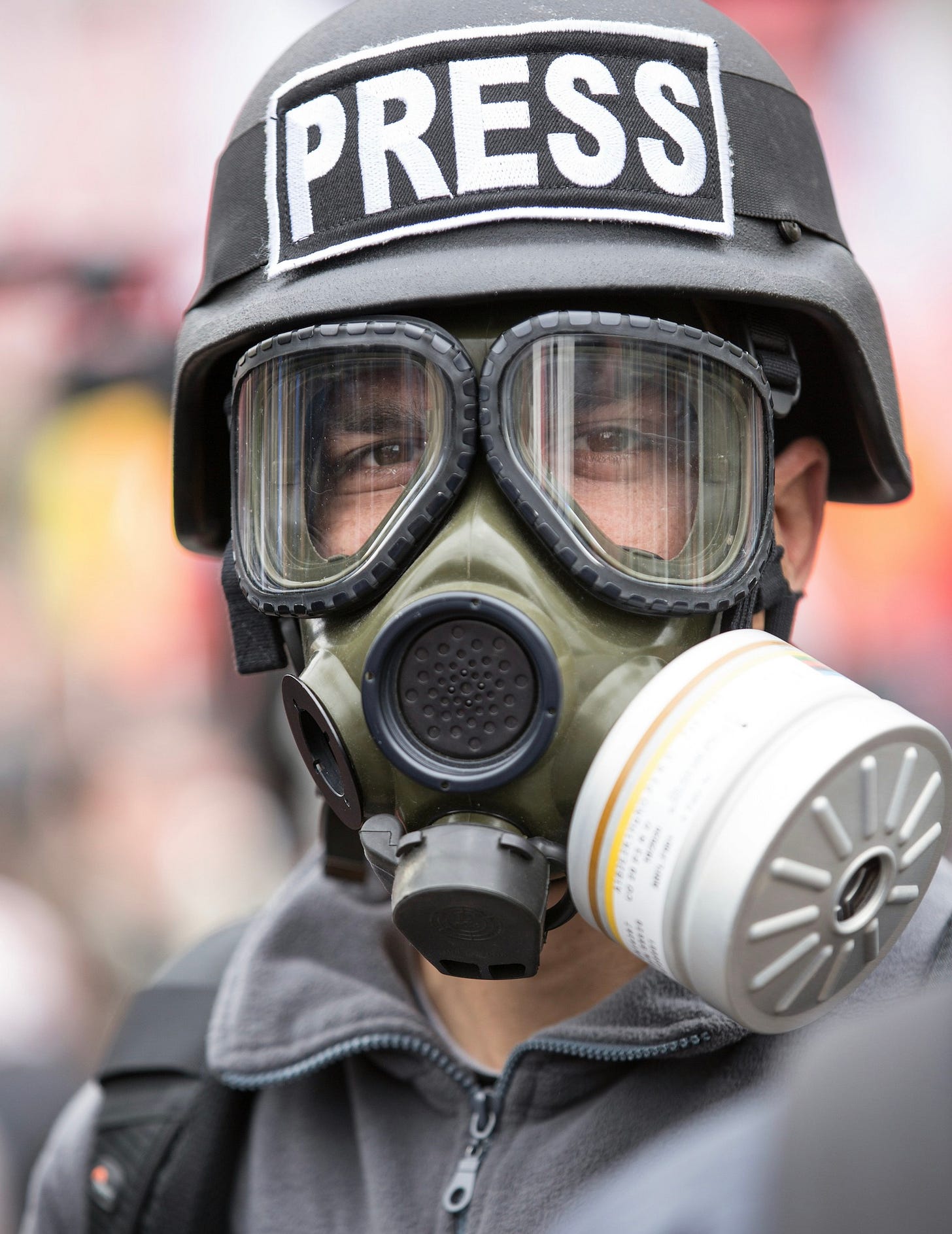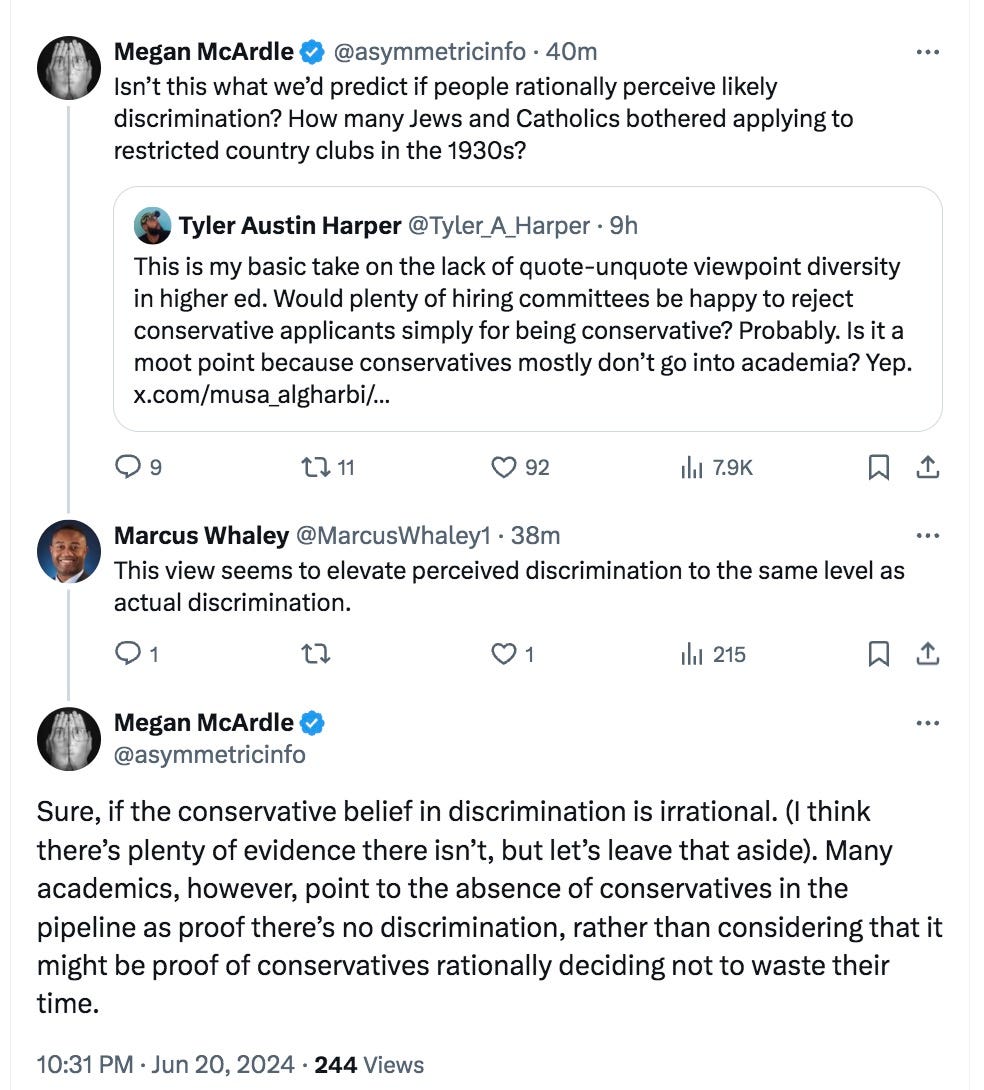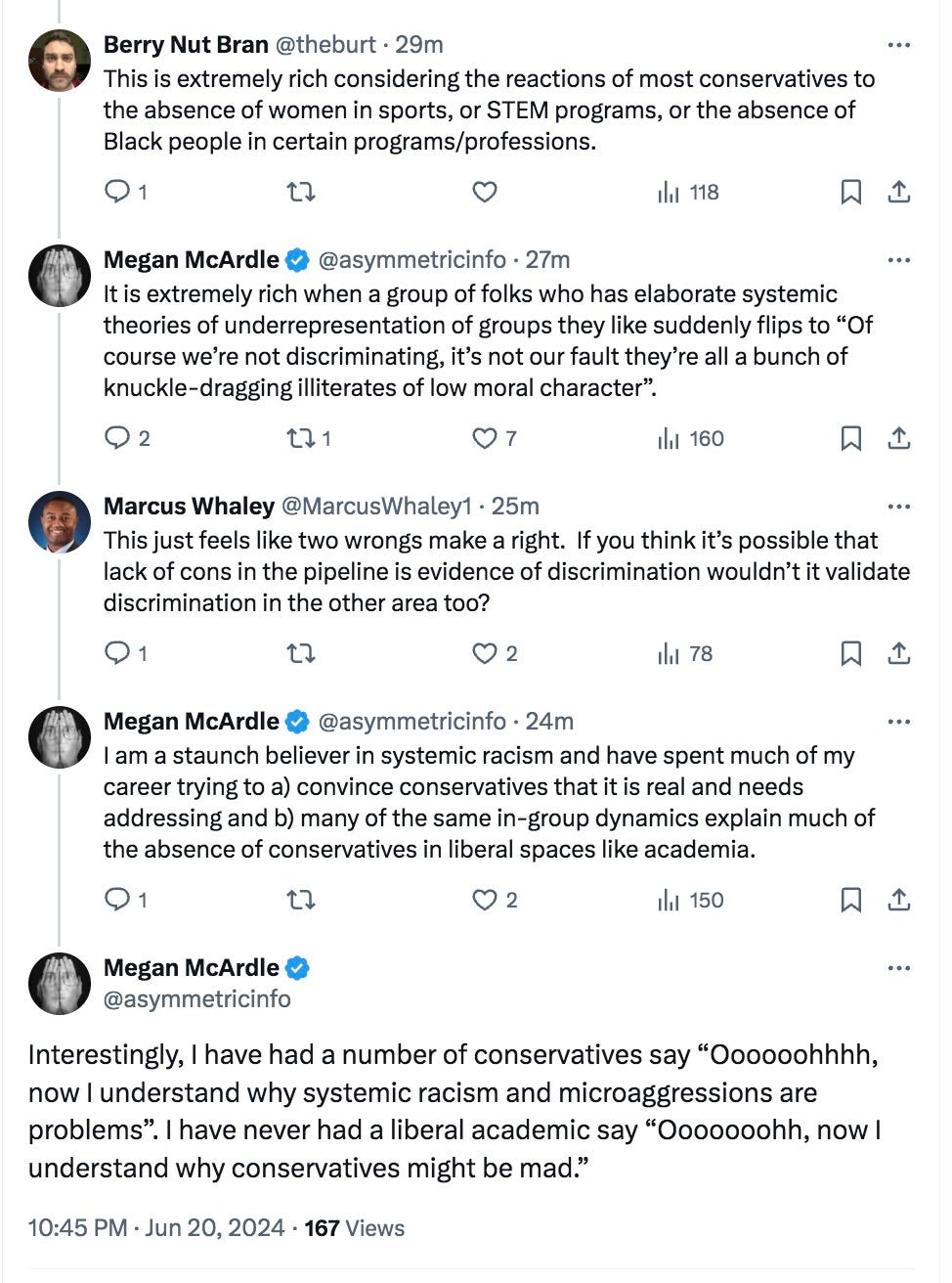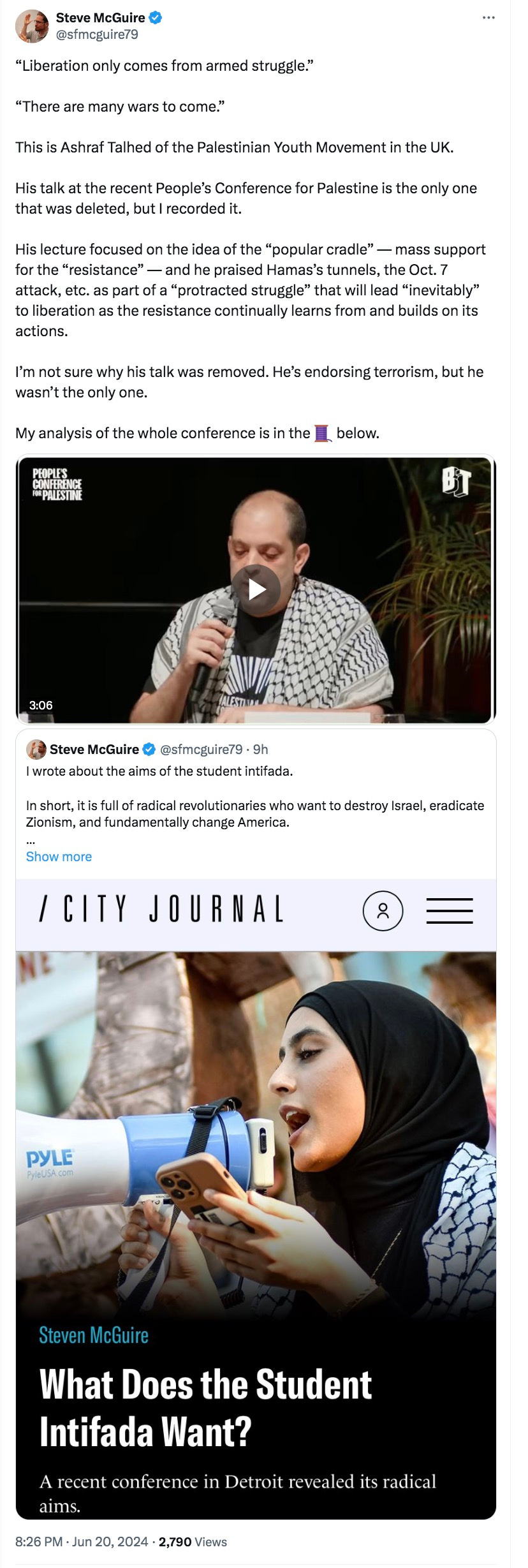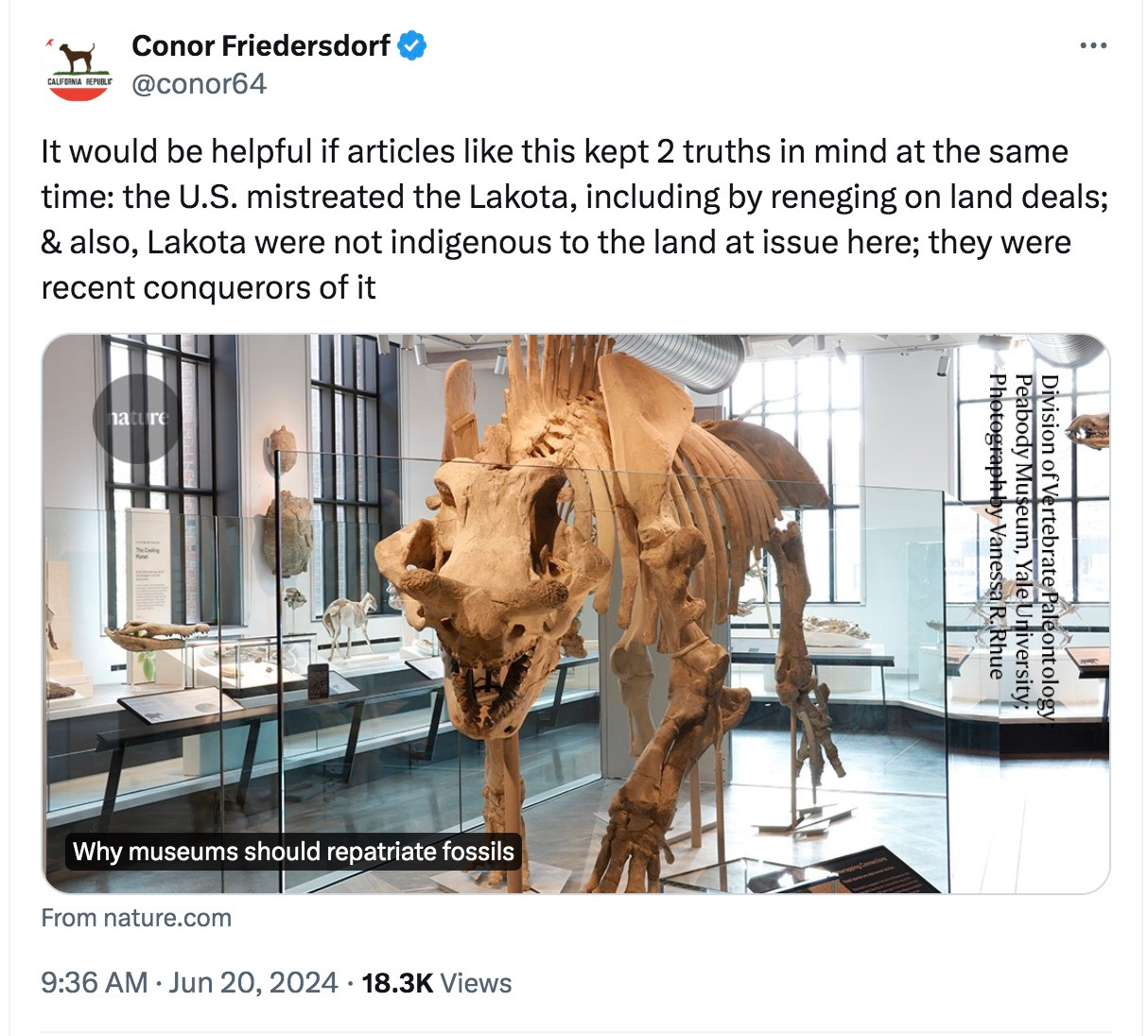E-Pluribus | June 21, 2024
The fog of war can be a smokescreen; moving journalism out of its ivory tower; and getting the story, the whole story and nothing but the story.
A round-up of the latest and best musings on the rise of illiberalism in the public discourse:
Charlotte Lawson: ‘The Story You’re Not Supposed to Cover’
News from a war zone should always be received with a grain (or 1000 grains) of salt. At The Dispatch, Charlotte Lawson writes that even that is not enough when the reporters involved have taken sides, as appears to have happened more than once in the current Israeli-Palestinian conflict.
An Israeli incursion into the central Gazan refugee camp of Nuseirat earlier this month left Abdallah Aljamal, a journalist publishing frequent dispatches from the war-torn Strip, dead in his home. The catch? The raid was actually an operation to free three Israeli civilians abducted by terrorists on October 7, and Aljamal, a known Hamas affiliate, was one of their captors.
That a self-proclaimed journalist was holding Israelis hostage came as no surprise to Israeli officials, who have long warned about Hamas’ manipulation of the media in Gaza. Nor did Aljamal’s regular contributions to a U.S.-based media outlet, the Palestine Chronicle, one of many websites spreading pro-Hamas propaganda in America and abroad. But his involvement—and its limited coverage by major international news agencies—may be indicative of a larger problem: Hamas’ weaponization of the press and the role of journalists as both witting and unwitting accomplices.
[. . .]
The Palestine Chronicle has sought to distance itself from Aljamal since three of the four hostages Israel rescued earlier this month—Andrey Kozlov, Almog Meir Jan, and Shlomi Ziv—were found in his charge. On June 7, a day before the Israeli operation, the news website listed him as a “correspondent for The Palestine Chronicle in the Gaza Strip.” Two days later, as Aljamal’s name began to circulate, the Chronicle updated his title to “contributor.”
The outlet has since sought to cast doubt on the validity of Israel’s account that the captives were found in the reporter’s home while simultaneously denying claims of his employment. “Aljamal’s relationship with the Palestine Chronicle was that of a freelance contributor,” the staff wrote in the slain terrorist’s obituary. “He was neither a staff writer nor a contractor.”
But Aljamal was not alone among those connected with the Chronicle in his support for Hamas and October 7. Baroud, the Chronicle’s U.S.-based editor-in-chief, set the website’s editorial tone just two days after the cross-border attack during an X space—a live chat on the social media site formerly known as Twitter—laden with praise for the perpetrators and misinformation about their victims.
[. . .]
[Editor-in-chief] Baroud and at least five of the Chronicle’s other published writers have contributed stories to Iranian state-run media, the Washington Free Beacon first reported last week. And the U.S.-based outlet’s ties to Tehran are equally clear in its own published work. One story hailed the recently deceased Iranian President Ebrahim Raisi—known to many as “the butcher of Tehran” for his persecution of religious and political minorities—as a “supporter of the oppressed.” Another described Iran as “the only regional power that constantly and unconditionally supported the Palestinian cause.” The Palestine Chronicle did not immediately respond to requests for comment or additional information.
[. . .]
Yet the Chronicle’s potential ties to terror organizations have received little attention from major U.S. media outlets—itself an indicator of the way in which many journalists approach the Israel-Hamas war. Instead of shedding light on the hostages’ captors, reporting on the rescue operation earlier this month has largely centered on an unsubstantiated civilian death toll.
Read the whole thing.
Alex Perez: Journalism Needs Cultural Adjacency
In the article above, the “reporters” were way too close to the story. But, Alex Perez writes at Persuasion, some level of “adjacency” is necessary for journalists to communicate their stories properly. Perez attributes at least some of the current journalistic disconnect to the elitism that has seeped into the field over time.
[A] sense of adjacency is rare in journalism now. The profession, once semi working-class, is now dominated by people who can afford exorbitantly expensive journalism degrees and have the luxury of taking on unpaid internships in which valuable connections are forged. The absence of journalists from “adjacent” backgrounds is troublesome because it creates blind spots in news coverage and often results in depicting lower classes and people of color as aliens. Of course, to the cultural elites, they often are aliens. So much of the Trump coverage over the last half decade or so, for instance when attempting to explain his appeal to a growing number of Hispanics, takes on the point of view of elite mystification. They’re constantly mystified, which then forces them to conjure up dubious theories that serve the function of easing their mystification. Working-class Hispanics can’t possibly like the brutish Trump, they think—they must be under the spell of disinformation.
Race, in particular, tends constantly to be talked about in a clinical and disconnected manner: the idea is to “study” people from different races instead of trying to understand them at their level. There’s often an obsession with words surrounding race—which is to say that it’s all theoretical. When you’re adjacent to many cultures, however, your friends from different backgrounds are merely your friends. There’s no talk of tokenism or “diversity” because your friends are actual living, breathing humans.
Adjacency lends to pragmatism, a word I don’t often hear in elite parlance. When you’re constantly in between worlds, having to navigate disparate social scenes, you develop a natural pragmatism. This pragmatism, often developed at an early age as a defense mechanism, becomes the guiding principle of the adjacent person. If you’re hanging out with an unsavory character, for instance, and you don’t want to get your ass kicked, you go with the flow. You might disagree with this person, but opposing theories don’t register with this kind of guy. To paraphrase Mike Tyson: Everyone’s got a theory until they get punched in the face. Those who have the luxury of strictly trafficking in the comfort of theories never face the possibility—literal or not—of getting punched in the face. Pragmatism, not ideology, is the way to go—this is how one must maneuver in a world in which theories or fashionable ideas hold no sway.
[. . .]
The relative absence of the adjacent figure in mainstream media—whether on the progressive or conservative side—has resulted in a sterilized environment, of two bubbles perpetually battling each other. It’s always been difficult for the adjacent figure to penetrate the elite world, but as the two bubbles have consolidated in their mutual obsession with each other, the marginal critic has been squeezed out. The difficulty lies in the ability of the adjacent figure to navigate disparate social scenes with the necessary authenticity to be allowed entry. He must understand the norms and nuances of elite culture, while simultaneously keeping a foot in the lower classes. It isn’t a matter of merely code-switching, as the differences between elite and non-elite go beyond conversational differences; it involves the far more difficult task of status switching—navigating between the rich world and the poor world. The adjacent figure, in elite spaces, may look the part and even sound the part, but something will always be slightly off. Maybe he still doesn’t know which fork to use or how to feel comfortable around old money. When the journalism world was slightly more working-class, the status switch wasn’t as difficult to navigate, but now a lower-class outsider must be attuned to the perpetually shifting language rules and norms. It probably isn’t worth the work for the outsider, and so he tends to leave, and the bubble consolidates again. Meanwhile, the status switch upon returning to the non-elite-world is just as jarring.
Read it all.
Peggy Noonan: The Purpose of Journalism Is to Get the Story
And what is journalism all about, anyway? Peggy Noonan breaks it down for us at The Wall Street Journal. It’s about the story, the story and…the story.
We are talking about journalism this week, about newspapers and warring newsrooms and lost readership and what to do. At bottom, though this gets lost, all the arguments are really about what journalism is.
Here is what it is.
It is a dark night on a vast plain. There are wild sounds—the hiss of prehistoric cicadas, the scream of a hyena. A tribe of cavemen sit grunting around a fire. An antelope turns on a spit. Suddenly another caveman runs in, breathlessly, from the bush. “Something happened,” he says. They all turn. “The tribe two hills over was killed by a pack of dire wolves. Everyone torn to pieces.”
Clamor, questions. How do you know? Did you see it? (He did, from a tree.) Are you sure they were wolves? “Yes, with huge heads and muscled torsos.” What did it look like? “Bloody.”
As he reports he is given water and a favored slice of meat. Because he has run far and is hungry, but mostly because he has told them the news, and they are grateful.
[. . .]
The purpose of journalism is to get the story and tell the story.
[. . .]
The past two decades, accelerating over the past four years, newsrooms have increasingly become distracted from their main mission, confused about their purpose. Really, they’ve grown detached from their mission. This has happened in other professions and is always hard to capture. But the journalistic product now being offered has become something vaguer than it was, more boring, less swashbuckling, more labored, as if it’s written by frightened people. There’s an emphasis on giving the story “context,” but the story doesn’t feel alive and the context seems skewed.
[. . .]
It is as if journalism is no longer about Get the Story but about Meeting People Where They Are and helping them navigate through a confusing world. But do you really think current editors know where people are? Do you think they know how to navigate? It all feels presumptuous.
[. . .]
More and more as I observe American journalism I miss the guys who were big TV news producers in the 1980s and ’90s. They were animals—real cavemen. They’d do anything to get the news. They yelled at people and pushed them around. But the people around them, they sure got the story.
Facebook and social media can’t get the story. They can amplify it, give an opinion, comment. But they don’t have the resources and expertise; they don’t have trained investigative journalists and first-class experienced editors and a publisher willing to take a chance and spend the money.
Read it all here.
Around Twitter (X)
The Washington Post’s Megan McArdle engaged several other X users in a conversation about the lack of conservatives in academia and what that might say about both conservatives and liberals:
Steve McGuire previews his first piece for City Journal:
And finally, while two wrongs never make a right, here’s a good reminder from Conor Friedersdorf that the oppressor-oppressed template isn’t always cut-and-dried:




